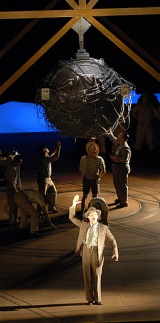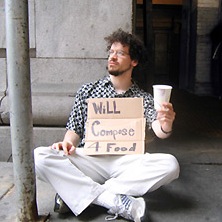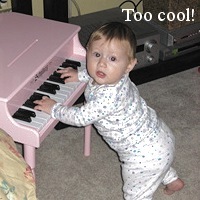On November 3rd, I sat down with David Lang at a cafe in Downtown Manhattan. I recorded the interview (on my iPod) intending to transcribe it, but the audio, while still marred by a lot of background noise, is actually listenable. Here it is:

 Concerning the quality of John Adams’s Doctor Atomic, currently playing at the Metropolitan Opera through November 13, I am of many minds. This may be due in no small part to the opera being of many minds itself. Doctor Atomic is about as good as any opera could be given that its creators do not seem to have a cogent idea of what drama is.
Concerning the quality of John Adams’s Doctor Atomic, currently playing at the Metropolitan Opera through November 13, I am of many minds. This may be due in no small part to the opera being of many minds itself. Doctor Atomic is about as good as any opera could be given that its creators do not seem to have a cogent idea of what drama is.
At first a documentary-style perspective on the events leading to the first atomic bomb test holds sway. In the first scene, the chorus and characters sing lines containing all the poetry of a Pentagon press briefing. (Adams’s program notes describe his and Peter Sellars’s scrupulousness in basing the libretto on language from primary sources.) But after the initial oddness, one gets used to hearing the chorus describe the structure of the bomb’s core and so forth. Then scene two arrives, and we’re in Puccini-land. Robert and Kitty Oppenheimer, in the intimacy of their bedroom, rhapsodize in florid soliloquies about their infinite, cosmic love for one another. In scene three, the opera begins to hit its stride by coming to favor panoramic montages over dramatic scenes. After intermission, Act II increases this trend: characters more often speak to us (or to no one) than to each other, and we wait and wait for the bomb to drop.
With so many different dramatic angles rubbing elbows–the documentary, the lyrical, the montage (and the first two do not disappear entirely in Act II)–awkward moments abound in Doctor Atomic. The beginning of the second scene is needlessly jarring; the discussion of General Groves’s diet in scene three does not belong here; the “earth-mother” lullaby (sung by the Oppenheimers’ Native-American nanny, Pasqualita) is portentous; after an inert debate about the possibility the bomb might ignite the atmosphere, Edward Teller, one of the scientists, offers everyone sun screen. The entire second act fails to establish a common consciousness from which characters’ lines can emerge logically: instead, these lines often sound arbitrary and pretentious. Kitty Oppenheimer is a character almost entirely without dramatic support from her surroundings: she seems out of place, despite some ravishing music; and even Doctor Atomic himself, despite his riveting John Donne aria that closes the first act, ends up being a weak center for the action.
But in the end Doctor Atomic is saved by the sheer talent of its composer. Adams’s score is absolutely fantastic. The tonality roves from chromatic to triadic with discretion and power; Adams’s command of rhythmic contrast–especially in how well the wildly exciting concluding countdown is prepared–is masterful; the orchestration is luscious and fluent; the vocal writing maneuvers deftly between the florid and the declamatory; the strident choral writing packs a wallop, especially in the Bhagavad Gita settings in the second act. And the entire musical component of the production, already at a high level, benefits from the inspired, committed conducting of Alan Gilbert, whose approaching tenure at the New York Philharmonic must be more eagerly anticipated than ever before.
Doctor Atomic‘s flaws are serious, and the second act in particular breaks down badly. But Adams’s power is at its zenith, and one continues to look forward to his coming creations.
We need somebody to do a pre-concert interview with Terry Riley and maybe review his Bang on a Can happening at Le Poisson Rouge on November 8. Free tickets, of course. Hands?
David Lang, who you will recall won this year’s Pulitzer with his piece The Little Match Girl Passion, will be submitting himself to the hard-hitting S21 interview next week. I’ll be asking him what he plans to do about the financial meltdown, the war in Iraq, and whether he stands by his selection of Sarah Palin as his running mate. Or something–I haven’t written the questions yet.
In the meantime, those of you who live in New York may want to know that Wordless Music is presenting a concert of Lang’s music next Wednesday, November 5th, at Le Poisson Rouge (158 Bleecker Street, New York). Doors at 7:00, show starts at 7:30. The show will consist of the American premiere of his piece Pierced with the Real Quiet. Special guests include the Flux Quartet and Theo Blackmann singing Lang’s version of Lou Reed¹s Velvet Underground song “Heroin.” Both pieces appear on Lang’s new Naxos disc, which I’ve been listening to a lot and recommend.
 For those of you who, like me, have been wondering whatever happened to the once ubiquitous S21 familiar Ian Moss but have been too forgetful to ask around, we have news of two upcoming concerts and an explanation for his absence.
For those of you who, like me, have been wondering whatever happened to the once ubiquitous S21 familiar Ian Moss but have been too forgetful to ask around, we have news of two upcoming concerts and an explanation for his absence.
The first concert is a surprise (well, I guess we gave it away) reunion show on Thursday night with Ian’s jazz/metal/awesomeness band, Capital M which will be playing a set of 100% improvised music at the old Knitting Factory Tap Bar, one of the legendary venues for experimental music in New York and, alas, another historic spot getting ready to flee the island for Brooklyn soon due to enormous pressures in the local real estate market. This will be one of last shows in the Tribeca location.
Thursday, October 30
Capital M @
Knitting Factory Tap Bar
74 Leonard Street
8pm (7:30 doors)
Then on Saturday, November 22, C4, the choral collective that Ian co-founded will present a concert called “Brazen Guns and Gentle Doves” at St. Joseph’s Church on the Upper East Side.
Saturday, November 22
C4: The Choral Composer/Conductor Collective
St. Joseph’s Church
404 E 87th Street
8pm
For more updates on the adventures of Ian, check out his blog, Createquity. p.s. He’s been going to business school, of all unlikely things.
 Kronos Plays Holmgreen: I don’t approve of recordings in which people talk while I’m trying to listen to music but I’m making an exception for the Kronos Quartet’s new Dacapo recording of works by the Danish composer Pelle Gudmundsen-Holmgreen. Kronos Plays Holmgreen is the culmination of 20 years of collaboration between Holmgreen and the Kronos Quartet, and includes his Concerto Grosso for string quartet and orchestra (1990; rev. 1995); Moving Still, written for Hans Christian Andersen’s bicentenary in 2005 and featuring Paul Hillier; and Last Ground, his Ninth String Quartet, written in 2006 and dedicated to the Kronos Quartet. Moving Still is the piece with the talking: in part one, Paul Hiller reads Hans Christian Andersen’s prophetic text In a Thousand Years, a Jules Verne-like fantasy predicting that Americans will one day be able to fly over the Atlantic and “see Europe in a week.” The text for part two comes from Andersen’s patriotic poem “Danmark er jeg født” (In Denmark I Was Born). If you don’t like talking, you can simply skip those cuts like I do. Holmgreen is a brilliant jokester, a kind of musical Samuel Beckett, drawing from Baroque music, Pygmy music, jazz, plainchant, the sounds of everyday life, and sheer noise to create music that is both absurd and sublime. The closest American counterpart I can think of is Sebastian Currier.
Kronos Plays Holmgreen: I don’t approve of recordings in which people talk while I’m trying to listen to music but I’m making an exception for the Kronos Quartet’s new Dacapo recording of works by the Danish composer Pelle Gudmundsen-Holmgreen. Kronos Plays Holmgreen is the culmination of 20 years of collaboration between Holmgreen and the Kronos Quartet, and includes his Concerto Grosso for string quartet and orchestra (1990; rev. 1995); Moving Still, written for Hans Christian Andersen’s bicentenary in 2005 and featuring Paul Hillier; and Last Ground, his Ninth String Quartet, written in 2006 and dedicated to the Kronos Quartet. Moving Still is the piece with the talking: in part one, Paul Hiller reads Hans Christian Andersen’s prophetic text In a Thousand Years, a Jules Verne-like fantasy predicting that Americans will one day be able to fly over the Atlantic and “see Europe in a week.” The text for part two comes from Andersen’s patriotic poem “Danmark er jeg født” (In Denmark I Was Born). If you don’t like talking, you can simply skip those cuts like I do. Holmgreen is a brilliant jokester, a kind of musical Samuel Beckett, drawing from Baroque music, Pygmy music, jazz, plainchant, the sounds of everyday life, and sheer noise to create music that is both absurd and sublime. The closest American counterpart I can think of is Sebastian Currier.
[youtube]http://www.youtube.com/watch?v=qFPS7-gg8Ng[/youtube]
Charles Neidich and friends are performing Messiaen’s Quartet for the End of Time and music by Israeli composers. The program is below, and you can check out the notes over at my blog.
Moshe Zorman – Hora
Arnaud Sussmann, Violin; Vincent Balse, Piano
Menachem Wiesenberg – Like Clay in the Potter’s Hand
Gal Nyska, Cello; Vincent Balse, Piano
Paul Ben Haim – Pastorale Variee Op. 31b
Moran Katz, Clarinet; Vincent Balse, Piano
Olivier Messiaen – Quartet for the End of Time
Charles Neidich, Clarinet; Arnaud Sussmann, Violin; Gal Nyska, Cello; Vincent Balse, Piano
Corey Dargel sings “All Other Sounds (for Brian from Molly)” from his new album Other People’s Love Songs, which will be officially released on Wednesday. Video directed by Oleg Dubson. (Correction from Corey: “The concert is tomorrow, but the album is released today (Tuesday) and is available from newamsterdamrecords.com as well as iTunes and eMusic, etc. Yay!”
[youtube]http://www.youtube.com/watch?v=F2CsQrg031s[/youtube]
Don’t tell me you’ve forgotten already!
Also: S21 concert update: The S21 concerts in December are the 1st at Waltz–that’s a changed date, yo–and the 5th at Good Shepherd Church (152 W 66th). On the program: Samuel Andreyev, Rusty Banks, Galen Brown, Rodney Lister, Alex Kotch, Jeremy Podgursky, me, and Samuel Vriezen. (Hope I didn’t leave anyone out.)
Later, er, today I’m handing in the second draft of my dissertation. It’s about Kurtag.
 Hi Jerry,
Hi Jerry,
We’re opening up a search for pianists for the Bang on a Can All Stars.
Please see the ad below . We’d appreciate this if you can make a post about this on Sequenza21.
Thanks!
Annie
Bang on a Can All-Stars Seek Pianist
“The Bang on a Can All-Stars present new music the way it should be presented — with passion, precision, dynamism, stylistic authority and a welcoming informality.” – NEWSDAY
“A fiercely aggressive group, combining the power and punch of a rock band with the precision and clarity of a chamber ensemble.”/- NEW YORK TIMES
The Bang on a Can All-Stars announce an immediate opening for the position of Piano. The All-Stars seek a pianist of exceptional ability who has a demonstrated commitment to the music of our time. Applicants should a) have outstanding chamber music skills and be skilled as a soloist, b) have an enthusiasm for working in a wide variety of styles and genres, c) be comfortable working with living composers in a traditional composer/performer relationship AND be engaged in the collaborative process of experimenting with unconventional musicians on boundary-breaking projects. Applicants must be available for approximately 15 weeks per year for concerts, US and International touring, recordings, the Bang on a Can Summer Festival, and special projects. Experience with amplification and knowledge of electronics is not required, but it is a plus. The Bang on a Can All-Stars are based in New York City. Residence in the vicinity of New York City or willingness to re-locate is not a requirement, but is preferred.
Application Procedure:
1) Applicants should send;
a) A short cover letter detailing their interest in the Bang on a Can All-Stars
b) A comprehensive resume
c) Three letters of recommendation
2) Applicants may be asked to submit recordings at a later date.
3) Selected applicants will be invited for a live audition and possibly to perform with the All-Stars.
4) Applications will considered on an ongoing basis, and will continue to be considered until the position is filled.
5) Send all application materials to:
Bang on a Can
Attention: Annie Chen
80 Hanson Place, Suite 701
Brooklyn NY 11217
USA
6) Applications should be post marked no later than November 14, 2008 to be eligible for the next round of auditions.
If you have any questions, please write to Annie Chen: annie@bangonacan.org or call 718-852-7755.
More information about Bang on a Can and the All-Stars: http://www.bangonacan.org/
